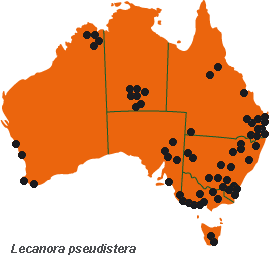



Australian Biological Resources Study
| Checklist of the Lichens of Australia and its Island Territories | ||
| Introduction | A–D | E–O | P–R | S–Z | Oceanic Islands | References | ||
| Lecanora pseudistera Nyl. | ||
| Flora 55: 354 (1872). T: Ligugé, Poitiers, France, 1872, H.A.Weddell; lecto: H-NYL 27208, fide I.M.Brodo, Beih. Nova Hedwigia 79: 150 (1984). *****Placodium glebulare Müll.Arg., Flora 71: 204 (1888); Lecanora glebularis (Müll.Arg.) Zahlbr., Cat. Lich. Univ. 5: 624 (1928). T: NW of L. Albacutya, Vic., 1888, C.French; holo: G. *****Lecanora convexella Räsänen, Arch. Soc. Zool.-Bot. Fenn. “Vanamo” 3: 180 (1948). T: N.S.W., 1892, F.R.M.Wilson 3; holo: H. *****Lecanora subfuscella Räsänen, Arch. Soc. Zool.-Bot. Fenn. “Vanamo” 3: 180 (1948). T: Eastern Creek, N.S.W., 1892, F.R.M.Wilson 2; holo: H. | ||
| Thallus dispersed-verrucose to areolate or subsquamulose, bullate, yellowish white to yellowish grey or whitish grey, epruinose, sometimes glossy. Soredia absent. Prothallus not visible. Apothecia immersed when immature, becoming sessile to slightly constricted at the base, 0.2–0.8 (–1.4) mm diam.; disc pale to dark red-brown, epruinose; margin concolorous with the thallus, thin, entire, ±verrucose to crenulate, often with a parathecial ring. Cortex hyaline, ±gelatinous, 15–20 µm thick laterally and 20–25 µm thick basally. Amphithecium with large crystals insoluble in KOH (pulicaris-type). Parathecium hyaline, 10–15 µm thick, with numerous small crystals soluble in KOH. Epihymenium reddish brown, K–, without crystals (glabrata-type), c. 10–15 µm thick, with a 2.5 µm thick hyaline layer above. Hymenium, subhymenium and hypothecium hyaline. Paraphyses sparingly branched and thickened apically. Ascospores ellipsoidal, 8.5–13.5 × 5.0–7.5 µm. CHEMISTRY: Thallus and apothecial margin K+ yellow, C–, Pd+ pale orange; containing atranorin (major), 2’-O-methylperlatolic acid (major), chloroatranorin (minor), ±2’-O-methylhyperlatolic acid (minor), 2’-O-methylisohyperlatolic acid (minor) and 2’-O-methyl-superlatolic acid (minor). |  |
|
| A saxicolous and terricolous species that is known from all States and Territories and Norfolk Is.; especially common in semi-arid regions. Also in Europe, the Americas, southern Africa, Asia, New Zealand and Oceania. | ||
| Lumbsch & Elix (2004) | ||
| Checklist Index |
| Introduction | A–D | E–O | P–R | S–Z | Oceanic Islands | References |
This work is copyright. Apart from any use as permitted under the Copyright Act 1968, no part may be reproduced by any process without prior written permission from Australian Biological Resources Study. Requests and inquiries concerning reproduction and rights should be addressed in the first instance to Dr P. McCarthy. These pages may not be displayed on, or downloaded to, any other server without the express permission of ABRS.